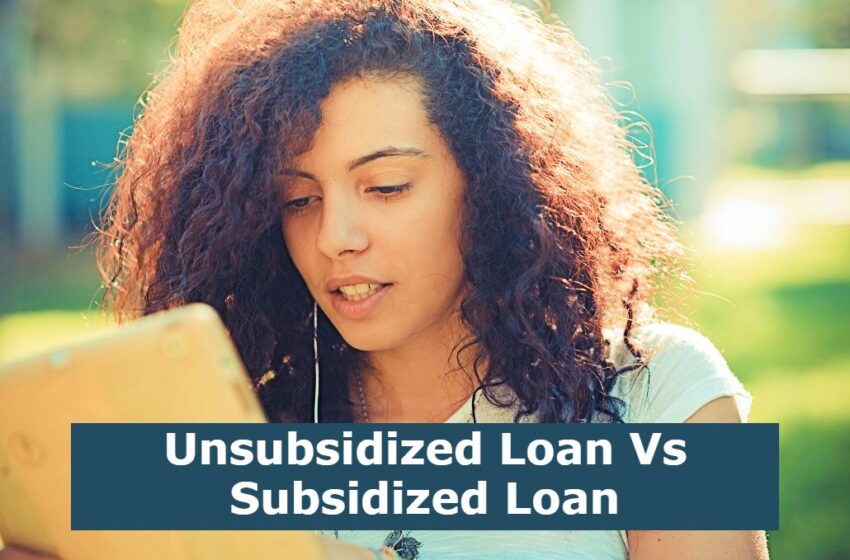
Unsubsidized Loan Vs Subsidized Loan
When it comes to taking out loans to pay for your school, there are two main types you can take out: unsubsidized loans and subsidized loans. While the unsubsidized loan is available to anyone, subsidized loans are only available to students who qualify, based on financial need.
Federal loans come with standardized fees and interest rates
If you are a student in need of a loan, you may qualify for a federal loan. These loans offer standard fees and interest rates. The Department of Education sets the terms of these loans.
Federal loans can be subsidized or unsubsidized. Subsidized loans do not accumulate interest during the period that you are in school. Unsubsidized loans add interest to the principal balance of the loan, which is your responsibility. However, you can opt for a payment deferment during your school career to lower the monthly payments.
Interest rates for federal loans tend to be low. There are no penalties for early repayment of these loans. However, there are still fees that you should know about. For example, you can apply for forbearance if you are having difficulty making your payments. Also, you can consolidate your existing loans into one single Direct Consolidation Loan.
Interest rates vary from lender to lender. You can also choose to make a fixed or variable payment, depending on your budget and credit history.
Unsubsidized loans are available to all students
If you need help paying for college, the federal government may be able to help you. But before applying, you should know a few things about the different types of student loans. There are subsidized loans and unsubsidized loans, and they’re available to undergraduates, graduate students, and professional degree students. Generally, subsidized loans offer the best repayment options.
Unlike other kinds of student loans, subsidized and unsubsidized loans do not require credit checks. In fact, the only requirements for eligibility are financial need and being enrolled in school. And since it’s federal funding, the dollar amounts are typically lower.
The total amount of subsidized and unsubsidized loans is determined by a student’s cost of attendance and other types of financial aid. A student’s loan limit, however, is limited by federal regulations. So, you won’t be able to borrow more than you really need.
Unsubsidized student loans are similar to subsidized ones in that you don’t have to pay them back while you’re in school. However, you do have to pay interest. This can add up to a huge expense if you delay your payments.
Direct subsidized loans are loans for undergraduate students with financial need
A Direct Subsidized Loan is a type of student loan that allows undergraduate students with financial need to borrow funds. These loans have low interest rates and are available to students who are in school at least half-time. There are some limitations to these loans. They must be repaid with interest.
First-year undergraduates may receive up to $9,500 in Direct Subsidized Loans for a single academic year. Students in certain health professions programs, such as nursing, may receive more than that amount. Professional students, such as medical school students, can borrow up to $224,000.
The maximum annual loan limit is $31,000 for dependent undergraduates, and $57,500 for independent students. However, these limits are prorated in some cases. If a student exceeds their annual loan limits, they can not receive additional loans until the next academic year.
Direct Unsubsidized Loans are also offered to students without financial need. During deferral periods, they do not accrue interest. They will begin accruing interest when the loan is disbursed. Once the loan is disbursed, the student has six months to repay it. This repayment period will be defined by the school.
Higher interest rates on unsubsidized loans
The federal government offers subsidized and unsubsidized student loans. These types of loans are available to undergraduate and graduate students. Each type has different interest rates, limits, and repayment options.
The Federal Direct Subsidized Loan (FCSSL) interest rate remains at 3.4 percent for the 2012-2013 academic year. It is based on the formulas in section 455 (b)(8) of the HEA.
Unsubsidized loans do not have a time limit for interest subsidy. If you are borrowing more than 150% of the length of your program, you will be responsible for paying the accumulated interest.
However, you have the option to capitalize your interest to the principal balance. This can increase the amount you have to repay. You can also choose to make interest-only payments. Interest-only payments will reduce compounding and can help you leave school with a lower debt.
Graduate students can borrow up to $20,500 per year. Dependent and independent undergraduates can borrow up to $31,000.
Federal PLUS loans are designed for parents of dependent undergraduate students. The interest rate on these loans is based on a 10-year Treasury bill plus an added percentage.


